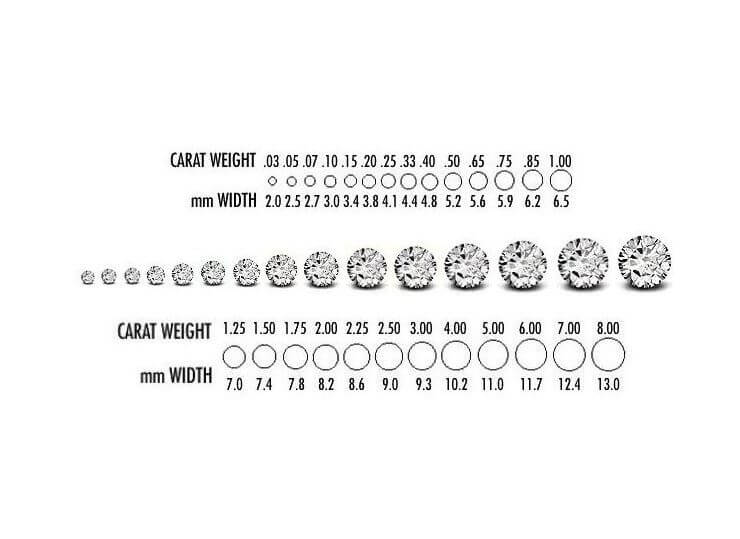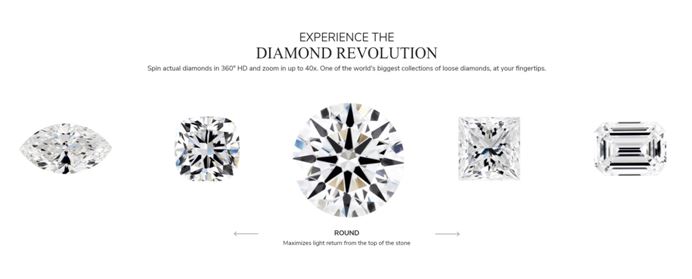Diamond carat weight is probably the 4C in which most clients are more familiar with, and it is also the most straightforward feature to describe and present to your customers since their size differences are more effectively discernible. Moreover, the carat weight plays an integral part in the overall value of a diamond because the larger diamonds are rarer and therefore are more expensive. However, simply because a diamond might look more significant, it does not mean if it will be the best choice for your customer.
Nonetheless, the overall diamond quality is being determined by all the 4Cs combined, and as a result, precious stone jewelers should put it clear to their customers that larger stones can magnify color, cut as well as the clarity for the better likewise sometimes for, the worse.
As a retailer, describing the pros and cons of a larger diamond, based on that specific precious stone combined characteristics, will pave the way for your customer to determine which qualities are most crucial to them and also if that particular stone is what they are searching for.
Defining Diamond Carat Weight
The standard weight unit for diamonds and other gemstones is referred to as the term carat. The name begins from the carob seed, which was the first unit of measure for precious stone brokers. In 1913 the United States actualized the cutting edge metric carat, which is equivalent to 0.2 grams, and other nations before long adopted the idea. Today, a carat implies something everywhere in the world.
A Diamond carat weight can be divided further into 100 points, thereby making it easy for very accurate measurements. In other words, this is critical for stone dealers to understand that a minimal difference in weight can affect the overall worth of the diamond as well as the pricing structure.
Carat Size Comparison of a Diamond
Diamonds sales are based on the carat, which is undoubtedly a unit of weight, although most individuals’ idea about a carat is the size. The word “carat” originates from the word “carob” seed, which is the original unit of measurement for stone dealers. Presently, a carat is equal to precisely 0.2 grams (about the weight of a paper clip). Carat weight is not related to the familiar-sounding karat, which refers to the purity of gold.
Two precious stones of equal carat weight based on other factors can have different costs and in understanding the uniqueness of carat weight, know your partner, if the heart of your recipient is set on a particular diamond size, then the carat weight will likely be the most essential factor in your search until the ideal size is attained.
Other criteria will then take on more importance, and most ladies can tell you the carat shape and weight of the diamond they desire, and most men as well can tell you the price.
As the diamond carat weight and size increase, so also the price of the stone increases at an expanding rate. Why? Because the digger the sand, the more rarely it becomes. Less than one out of one million rough stones mined are large enough to produce a well finished 1-carat diamond. Therefore, as carat weight moves up, you will surely pay more not only in total but based on price-per-carat as well.
The table shown below illustrates the real connection between stones of equal quality and also increasing carat weights:
| Carat Weight | 1.00 | 2.00 | 3.00 |
| Price-per-carat | $ 6,000 | $ 12,000 | $ 18,000 |
| Total Price | $ 6,000 | $ 24,000 | $ 54,000 |
Carat Size Chart of a Diamond
Even though the price of a diamond exponentially increases with the carat weight, the real size does not. The table below displays the typical size connection between stones of increasing carat weights.
At this point, it is essential to note that when carat weight triples significantly from 1 to 3 carats, the perceived size roughly triples as well, however the diameter only increases by 45 percent from 6.50 to 9.40, and crown area, the surface area is visible when the diamond is set slightly more than doubles.
| Carat Weight | 1.00 | 2.00 | 3.00 |
| Approximate Size | 1-carat diamond | 2-carat diamond | 3-carat diamond |
| Diameter (mm) | 6.50 | 8.20 | 9.40 |
| Crown (mm2) | 33.2 | 52.8 | 69.4 |
This is essential to remember when searching for diamonds of any shape; a given increase in measurement will yield a more noticeable increase in surface (crown) area and overall size. While the third diamond has a roughly 50 percent greater height than the first, it certainly appears more than 50 percent larger.
When going for precious stones, check the listed measurements for each stone to have an idea of its size. The width and length will accurately tell you how large the diamond will show when viewed from above.
Diamonds of the same carat weight and shape may still look different in size based on the proportions of the cut. A well-cut diamond has a higher proportion of its total weight “hidden” inside, resulting in a smaller measurement than a stone that is well-cut.
These distinctions are usually small, yet noticeable and a well-cut stone may even have a lower carat weight slightly than a diamond that is deeply cut, still have a larger diameter, making it have a more significant substantial appearance in size.
Comparison of Diamond Carat Size
Approximate size
The precious stone images shown are a very close estimation of the real size of a 1 carat brilliant cut for each shape. Visually, the longer forms tend to show more to the eye than the square and round shapes.
Measurements Length x Width
The stones measurements correspond with the shape shown above and are also real for cut diamonds that are high 1-carat weight. For instance, two people, one is tall and thin, and the other who is short and stout might be of the same weigh in the bathroom scale, and that means two diamonds that seem to be different in sizes might have the same carat weight. That is due to variations in shape as well as cut make diamonds weights of similar look different. Since the distribution of carat weight over the entire diamond, other measurements are then needed to describe the overall size:
The total surface area (mm2) – Crown Area
The city gives the exact size of the precious stone face up (as it would show up when setting in a ring). For instance, while the oval precious stone picture appears to be broader than the round model, the whole surface region is the equivalent for the two shapes, which means the distinction in size is one of discernment, not reality.
Interestingly, the oval does not just show up higher than the princess cut. However, it additionally has a more significant surface territory (around 10% bigger in this model), which means the thing that matters isn’t merely a deception made by the prolonged shape.
Cut Proportions – if two precious stones are a similar carat weight and shape, yet one carries a higher percentage of its significance in its depths, at that point the table rate (level segment at the most upper end of the jewel) and generally crown region will be smaller, giving the impression that the precious stone is lower from the top. The picture (right) demonstrates two one carat. Round precious stones, however, the jewel on the left is cut more inside and out, and along these lines has a smaller table rate over the top.
Shape – precious stone shapes, for example, oval or marquise, have lengthened angles, bringing about the presence of a bigger size for every carat weight. Now and then, this size contrast can be genuine.
It is necessary to disclose to your clients how these various variables influence the view of a jewel size. A precious stone with a higher carat weight is probably going to be increasingly costly, yet may not look that a lot bigger than a littler carat weight jewel once set in gems. Help your clients discover a precious stone that gives the broadest impression of size for the adornments setting them like while remaining within their budget limit.
Carat Rarity, Weight, and Pricing
The bigger a precious stone is, the rarer it is, so as the carat weight of a jewel increases, the stone’s cost can likewise increase. Moreover, jewel costs seize the full-and half-carat loads. Not exclusively is there a general cost climb; however as the carat weight builds, the value per-carat moves too. Stones just below this cut-off cost impressively less, and because the mass of the carat is distributed over the entire jewel, size difference can be hard to identify.
Keep in mind that while the measurements below are common, each stone is exceptional.
| Size | ||||||||||
| Length x Width | 6.50 x 6.50 | 5.58 x 5.46 | .76 x 5.69 | 10.18 x 5.33 | 8.67 x 5.66 | 6.12 x 5.69 | 6.57 x 5.09 | 5.68 x 5.60 | 6.35 x 5.39 | 6.14 x 6.89 |
| Crown (mm2) | 33.2 | 30.2 | 33.3 | 36.9 | 34.0 | 29.2 | 31.8 | 28.7 | 32.1 | 28.1 |
Conclusion
Your clients must understand that carat is a proportion of weight and not the physical size that the eye sees. Carat weight can tremendously affect a precious stone’s worth, and for individual clients, this will be a severe factor. In any case, for other people, what is important is the size of a diamond has all the earmarks of being from the top when setting in gems.
As little changes in carat weight can have little effect on the overall size appearance of a precious stone, however still affect the value, you should manage your customers to locate the correct cut and set to mirror the ideal jewel size within their financial limit.

